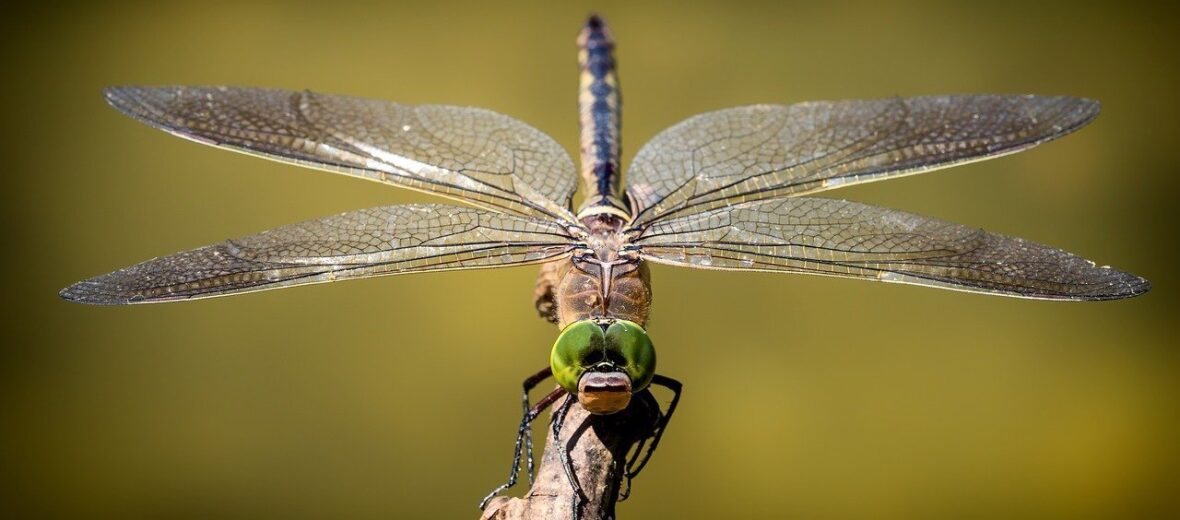
There is something really cool about dragonflies. Most other flying insects bite, sting, or pester you. Dragonflies just seem to be in a class all their own. These insects have been around for hundreds of millions of years, seemingly unchanged, sans their reduction is size. They come in a variety if sizes, body styles, and colors and they are fierce predators capable of mid-flight kills.
First the Stats…
Scientific name: Anisoptera
Length: Up to 4 inches
Lifespan: Up to 6 months
Now the cool facts
1.) In their larval stage, which can last up to two years, dragonflies are aquatic and eat just about anything—tadpoles, mosquitoes, fish, other insect larvae and even each other.
2.) Currently about 5,000 species of dragonflies and damselflies are known; experts guess that there are probably between 5500 and 6500 species in total! All of these (along with damselflies) belong to the order Odonata, which means “toothed one” in Greek and refers to the dragonfly’s serrated teeth.
3.) Dragonflies were some of the first winged insects to evolve, approximately 300 million years ago.
4.) Modern dragonflies have wingspans of around 2 – 5 inches, but fossil dragonflies have been found with wingspans of up to 2 feet!
5.) Dragonflies can fly straight up and down, hover like a helicopter and even mate in mid-air. If they can’t fly, they’ll starve because they only eat prey they catch while flying.
But wait, there’s more on the dragonfly!
6.) Dragonflies catch their insect prey by grabbing it with their feet. They’re so efficient in their hunting that, in one Harvard University study, the dragonflies caught 90 to 95 percent of the prey released into their enclosure.
7.) At the end of its larval stage, the dragonfly crawls out of the water, then its exoskeleton cracks open and releases the insect’s abdomen, which had been packed in like a telescope. Its four wings come out, and they dry and harden over the next several hours to days, and grow as they dry.
Did you know…?
It is estimated that the top speed for a dragonfly is between 19 – 38 mph! The maximum flight speed varies much between different species, with bigger dragonflies generally flying faster than smaller ones.
8.) The giant forest damselfly (Megaloprepus coerulatus) of Central America has a wingspan up to 7.5 inches! The bulkiest known dragonfly is the giant petaltail (Petalura ingentissima) from Australia, with a wingspan up to 6.5 inches!
9.) Some adult dragonflies live for only a few weeks while others live up to a year.
10.) Hundreds of dragonflies of various species will gather in swarms, either for feeding or migration. Not much is known about this behavior, but the Dragonfly Swarm Project is collecting reports on swarms to better understand the behavior. Have you ever seen a swarm?
But wait, there’s still more on the dragonfly!
11.) Scientists have tracked migratory dragonflies by attaching tiny transmitters to wings with a combination of eyelash adhesive and superglue. They found that green darners from New Jersey traveled only every third day and an average of 7.5 miles per day (though one dragonfly traveled 100 miles in a single day!)
12.) Dragonflies have near-360-degree vision, with just one blind spot directly behind them!
13.) What does a dragonfly eat? Insects, as adults, and they are a great controller of the mosquito population. A single dragonfly can eat 30 to hundreds of mosquitoes per day.
14.) One dragonfly called the globe skinner (Pantala flavescens) has the longest migration of any insect. It flies approximately 11,000 miles back and forth across the Indian Ocean!
15.) One research team has determined that the nervous system of a dragonfly displays an almost human capacity for selective attention, able to focus on a single prey as it flies amid a cloud of similarly fluttering insects, just as a guest at a party can attend to a friend’s words while ignoring the background chatter.
But wait, there’s even more on the dragonfly!
16.) Thankfully, dragonflies can’t bite humans. The vast majority of species don’t have mandibles strong enough to break the skin. Only a small handful of large species are capable of actually biting, but this only occurs as a defensive strategy.
Did you know…?
Humans have what’s known as tri-chromatic vision, which means we see colors as a combination of red, blue and green. This is all thanks to 3 different types of light-sensitive proteins in our eyes, called opsins. We are not alone: di-, tri- and tetra-chromatic vision is the norm in the animal kingdom. A study of 12 dragonfly species has found that each one has 11, and some a whopping 30, different visual opsins!
17.) Some species of dragonfly, such as the seaside dragonlet (Erythrodiplax berenicei) can successfully produce offspring in water much saltier than the ocean.
18.) What enemies does the dragonfly and damselfly have? Birds, spiders, frogs, and larger dragonflies. In the larval stage, they are preyed on by fish, frogs, toads and newts, and other water invertebrates; including other dragonflies.
Now a Short Dragonfly Video!
Want to suggest a critter for me to write about? Let me know here.
Learn more about all kinds of cool critters, right here!
Some content from: Wikipedia



